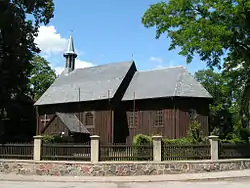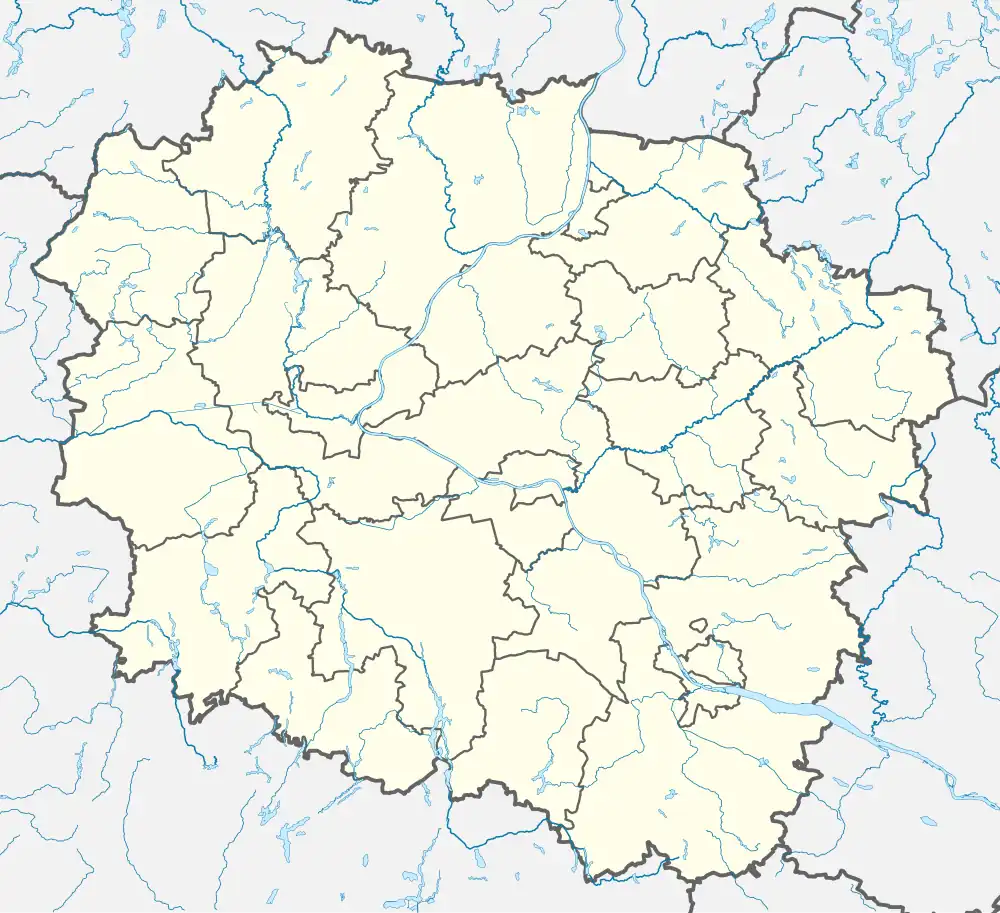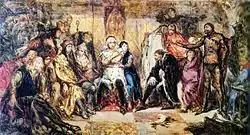Gąsawa | |
|---|---|
 Saint Nicholas Church | |
 Flag  Coat of arms | |
 Gąsawa  Gąsawa | |
| Coordinates: 52°46′N 17°45′E / 52.767°N 17.750°E | |
| Country | |
| Voivodeship | Kuyavian-Pomeranian |
| County | Żnin |
| Gmina | Gąsawa |
| First mentioned | 1136 |
| Town rights | 1338 |
| deprivation of town rights | 13 June 1934 |
| re-granting of town rights | 1 January 2024 |
| Population | |
| • Total | 1,400 |
| Time zone | UTC+1 (CET) |
| • Summer (DST) | UTC+2 (CEST) |
| Vehicle registration | CZN |
| Website | http://www.gasawa.pl/ |
Gąsawa [ɡɔ̃ˈsava] is a town in Żnin County, Kuyavian-Pomeranian Voivodeship, in north-central Poland. It is the seat of the gmina (administrative district) called Gmina Gąsawa. It lies approximately 10 kilometres (6 mi) south of Żnin and 43 km (27 mi) south-west of Bydgoszcz. It is situated on the western shore of the Gąsawskie Lake in the region of Pałuki.
History

The oldest known mention of the village comes from the Bull of Gniezno from 1136, when it was part of Piast-ruled Poland. It is famous as the place of the assassination of Leszek I the White, High Duke of Poland (November 23, 1227). Gąsawa received town rights in 1388 from King Władysław II Jagiełło and lost them in 1934. The town name appears as "Gonzawa", "Gonsawa", or "Gassawa" in certain older documents.[1] It was a private church town, administratively located in the Gniezno County in the Kalisz Voivodeship in the Greater Poland Province of the Kingdom of Poland.[2]
In 1600 Gąsawa hosted the Lubrański Academy (Polish: Kolegium Lubrańskiego) which temporarily moved out of plague-stricken Poznań.
In the late 18th-century Partitions of Poland it was annexed by Prussia. In 1807 it was regained by Poles and included within the short-lived Polish Duchy of Warsaw. Following the duchy's dissolution in 1815, it was reannexed by Prussia, and from 1871 it also formed part of Germany. Following World War I, in 1918, Poland regained independence and the Greater Poland uprising against Germany broke out, during which the Poles regained control of Gąsawa.
Following the joint German-Soviet invasion of Poland, which started World War II in September 1939, it was occupied by Germany until 1945. The Germans renamed it to Gerlingen to erase traces of Polish origin. In 1940, the occupiers carried out expulsions of Poles, particularly owners of larger farms, which were then handed over to German colonists as part of the Lebensraum policy, while the Poles were deported to the General Government in the more eastern part of German-occupied Poland.[3]
Sights
.JPG.webp)
The main tourist attraction in Gąsawa is the 17th century wooden St. Nicolas Church with a unique collection of multi-layered mural paintings, the earliest from the 17th century, and the most recent from 1807.[4]
The church itself, a larch construction with a slate roof, was in such a bad state around 1850 that local officials asked the regional Prussian government to allow the church to be dismantled and build a new one instead. The response gave permission to only overhaul the building. Existing wall paintings were covered with a layer of reed and ordinary plaster, and forgotten for some 150 years.[5][6]
At the local parish cemetery there are graves of fallen Polish insurgents of the Greater Poland uprising (1918–1919).[7]
References
- ↑ Wuttke, Heinrich (1 January 1864). "Codex diplomaticus magni ducatus Posnaniensis". Fries – via Google Books.
- ↑ Atlas historyczny Polski. Wielkopolska w drugiej połowie XVI wieku. Część I. Mapy, plany (in Polish). Warsaw: Institute of History, Polish Academy of Sciences. 2017. p. 1b.
- ↑ Wardzyńska, Maria (2017). Wysiedlenia ludności polskiej z okupowanych ziem polskich włączonych do III Rzeszy w latach 1939-1945 (in Polish). Warsaw: IPN. pp. 239–240. ISBN 978-83-8098-174-4.
- ↑ "CEJSH Publication information". Archived from the original on 2007-09-26. Retrieved 2007-07-03. Iconographic Baroque mural paintings in a wooden church accessed 3 July 2007
- ↑ Archived 2016-03-03 at the Wayback Machine Saint Nicolas' Church in Gasawa. accessed 7 July 2007
- ↑ Monuments of Sacred Architecture, Żnin county official website accessed 7 July 2007
- ↑ "GĄSAWA (wieś gminna w powiecie żnińskim)". Instytut Pamięci Narodowej (in Polish). Retrieved 27 November 2021.